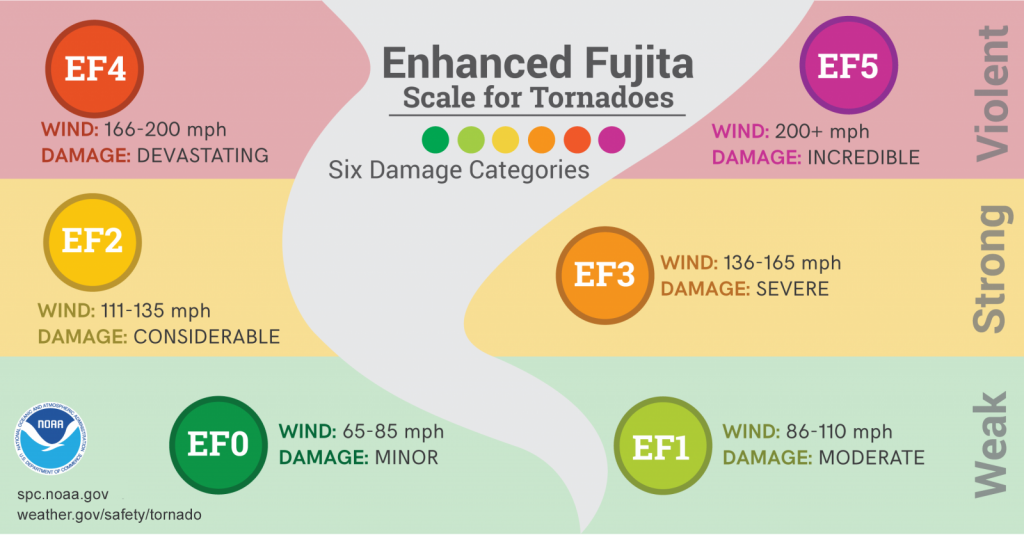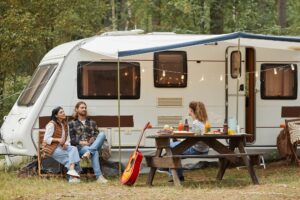Tornadoes are nature’s most violent storms. They are natural disasters that can leave devastating impacts on homes, families, businesses and communities. The peak season for Tornadoes is between March and May.
Spawned from powerful thunderstorms, tornadoes can cause fatalities and devastate a neighborhood in seconds. A tornado appears as a rotating, funnel-shaped cloud that extends from a thunderstorm to the ground with whirling winds that can reach 300 miles per hour. Damage paths can be in excess of one mile wide and 50 miles long. Every state is at some risk from this hazard. Some tornadoes are clearly visible, while rain or nearby low-hanging clouds obscure others. Occasionally, tornadoes develop so rapidly that little, if any, advance warning is possible. Before a tornado hits, the wind may die down and the air may become very still. A cloud of debris can mark the location of a tornado even if a funnel is not visible. Tornadoes generally occur near the trailing edge of a thunderstorm. It is not uncommon to see clear, sunlit skies behind a tornado.
Before a Tornado
There are some simple steps you can take to protect your home and family from tornadoes:
• To begin preparing, you should build an emergency kit and make a family communication plan. Please contact Acentria if you would like us to provide you with an emergency kit checklist or sample family communication plan.
• Listen to NOAA Weather radio, commercial radio, or television newscasts for the latest information. In an emergency, always listen to the instructions given by local emergency management officials.
• Be alert to changing weather conditions. Look for approaching storms.
• Look for the following danger signs:
o Dark, often greenish sky
o Large hail
o A large, dark, low-lying cloud—particularly if rotating
o Loud roar, similar to a freight train.
o If you see approaching storms or any of the danger signs, be prepared to take shelter immediately.
During a Tornado
If you are under a tornado warning, seek shelter immediately. Most injuries associated with high winds are from flying debris, so remember to protect your head.
If you are:
•In a structure (e.g., residence, small building, school, nursing home, hospital, factory, shopping center, high-rise building)
• Go to a pre-designated shelter area such as a safe room, basement, storm cellar or the lowest building level. If there is no basement, go to the center of an interior room on the lowest level (e.g., closet, interior hallway) away from corners, windows, doors and outside walls. Put as many walls as possible between you and the outside. Get under a sturdy table and use your arms to protect your head and neck.
• In a high-rise building, go to a small interior room or hallway on the lowest floor possible.
• Put on sturdy shoes.
• Do not open windows.
• In a trailer or mobile home
• Get out immediately and go to the lowest floor of a nearby sturdy building or a storm shelter. Mobile homes, even if tied down, offer little protection from tornadoes.
•Outside with no shelter
• Immediately get into a vehicle, buckle your seat belt and try to drive to the closest sturdy shelter.
• If your vehicle is hit by flying debris while you are driving, pull over and park.
• Stay in the car with the seat belt on. Put your head down below the windows; cover your head with your hands and a blanket, coat or other cushion if possible.
• If you can safely get noticeably lower than the level of the roadway, leave your car and lie in that area, covering your head with your hands.
• Do not get under an overpass or bridge. You are safer in a low, flat location.
• Never try to outrun a tornado in a car or truck in urban or congested areas. Instead, leave the vehicle immediately for safe shelter.
• Watch out for flying debris. Flying debris from tornadoes causes most fatalities and injuries.
After a Tornado
Injury may result from the direct impact of a tornado, or it may occur afterward when people walk among debris and enter damaged buildings. A study of injuries after a tornado in Marion, Illinois, showed that 50 percent of the tornado-related injuries were suffered during rescue attempts, cleanup and other post-tornado activities. Nearly one-third of those injuries resulted from stepping on nails. Because tornadoes often damage power lines, gas lines and electrical systems, there is a risk of fire, electrocution or explosion. Protecting yourself and your family requires promptly treating any injuries suffered during the storm and using extreme care to avoid further hazards.
Do not attempt to move seriously injured people unless they are in immediate danger of further injury. Get medical assistance immediately. If someone has stopped breathing, begin CPR if you are trained to do so. Stop a bleeding injury by applying direct pressure to the wound. Have puncture wounds evaluated by a physician. If you are trapped, try to attract attention to your location.
General Safety Precautions
Here are some safety precautions that could help you avoid injury after a tornado:
• Continue to monitor your battery-powered radio or television for emergency information.
• Be careful when entering any structure that has been damaged.
• Wear sturdy shoes or boots, long sleeves, and gloves when handling or walking on or near debris.
• Be aware of hazards from exposed nails and broken glass.
• Do not touch downed power lines or objects in contact with downed lines. Report electrical hazards to the police and the utility company.
• Use battery-powered lanterns rather than candles, if possible, to light homes without electrical power. If you use candles, make sure they are in safe holders away from curtains, paper, wood or other flammable items. Never leave a candle burning when you are out of the room.
• Never use generators, pressure washers, grills, camp stoves or other gasoline, propane, natural gas or charcoal-burning devices inside your home, basement, garage or camper—or even outside near an open window, door or vent. These devices can produce carbon monoxide (CO), an odorless, colorless gas that can cause sudden illness and death if it builds up inside your home. Seek prompt medical attention if you suspect CO poisoning and are feeling dizzy, light-headed or nauseated.
• Hang up displaced telephone receivers that may have been knocked off by the tornado, but stay off the telephone, except to report an emergency.
• Cooperate fully with public safety officials.
• Respond to requests for volunteer assistance by police, firefighters, emergency management and relief organizations, but do not go into damaged areas unless assistance has been requested. Your presence could hamper relief efforts and you could endanger yourself.
Inspecting the Damage
You may be tempted to inspect the damage a tornado causes immediately after a storm, but keep these safety tips in mind:
• After a tornado, be aware of possible structural, electrical or gas-leak hazards in your home. Contact your local city or county building inspectors for information on structural safety codes and standards. They may also offer suggestions on finding a qualified contractor to do work for you.
• In general, if you suspect any damage to your home, shut off electrical power, natural gas and propane tanks to avoid fire, electrocution or explosions.
• If it is dark when you are inspecting your home, use a flashlight rather than a candle or torch to avoid the risk of fire or explosion in a damaged home.
• If you see frayed wiring or sparks, or if there is an odor of something burning, you should immediately shut off the electrical system at the main circuit breaker if you have not done so already.
• If you smell gas or suspect a leak, turn off the main gas valve, open all windows and leave the house immediately. Notify the gas company, the police or fire departments or the State Fire Marshal’s office and do not turn on the lights, light matches, smoke or do anything that could cause a spark. Do not return to your house until you are told it is safe to do so.
Safety During Cleanup
Keep these points in mind when cleaning after a tornado:
• Wear long sleeves, gloves, and sturdy shoes or boots.
• Learn proper safety procedures and operating instructions before operating any gas-powered or electric-powered saws or tools.
• Clean up spilled medicines, drugs, flammable liquids and other potentially hazardous materials.
In addition to insuring your home, we are committed to helping you and your loved ones stay safe when disaster strikes. If you would like more information on developing a family emergency plan or building a disaster supply kit, please contact us today.
























